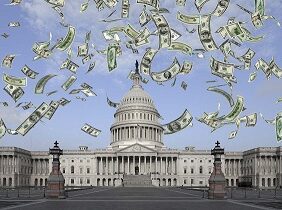Like the requests for almost all other agencies, the President’s FY 2022 budget request for the U.S. Forest Service calls for a huge boost in spending. The budget proposes $8.4 billion in discretionary funding for the Forest Service, an increase of nearly $1 billion from the allocation for FY 2021. The line items targeted for the increased funds largely reflect the administration’s prioritization of climate change mitigation, especially the increased threat from wildfires. But there’s no nod to cutting costs elsewhere to cover the new spending.
The Forest Service largely funds its wildfire-related operations through its Wildland Fire Management programs. An additional reserve fund and a special account allow the Forest Service access to more funding if the cost of fighting (aka suppressing) fires exceeds budgeted amounts. Altogether, the FY 2022 budget proposes $4.2 billion for the wildfire accounts, or exactly half of the agency’s budget. Those accounts and the related budget for Hazardous Fuels reduction would receive nearly $400 million more than FY 2021 under the budget request.
But wildfire spending also accounts for increases to the Forest Service budget for several other programs. The agency requests $66 million more than last year for Collaborative Forest Landscape Restoration for “wildfire risk management.” Vegetation and Watershed Management would get $47 million more for post-wildfire restoration work. Even Grazing Management gets $3 million more in the request to “target grazing for hazardous fuels reduction.”
The Forest Service tends to minimize the portion of its operations devoted to management of logging in National Forests. But timber management is costly, with more than half a billion spent on it in FY 2020, not including roadwork spending that often enables timber harvest. In return for timber harvested in National Forests, however, taxpayers got just $110 million in revenue in FY 2020. Taxpayers lose hundreds of millions of dollars every year on the Forest Service’s below-cost timber sales. Now, the agency is proposing to spend more to get less.
Like the spending bumps for other programs, the FY 2022 budget requests new spending for the Forest Products (i.e. timber sales) program for fire-related activities. According to the agency, the extra $10 million would be used “to implement projects that have a commercial and/or sub-commercial timber component along with hazardous fuels reduction.” That means taxpayers can’t expect much revenue in return. Such spending might constitute reasonable wildfire prevention. But to cover it, the agency should stop subsidizing the felling of old trees that sequester carbon and reduce national emissions, at least in the near-term.
The Forest Service should also look to its budget for roadbuilding for savings. According to the budget request, the agency has more than $5.2 billion in deferred maintenance on its roads, trails, and bridges. Addressing that backlog should be a top priority before jumping into new and expanded capital spending. The backlog is likely to diminish, however, with the influx of funds devoted to deferred maintenance from the National Parks and Public Land Legacy Restoration Fund authorized by the Great American Outdoors Act passed in 2020. Those funds ultimately come from receipts from oil, gas, and coal development on federal lands that would have otherwise been deposited in the Treasury.
Lastly, the USFS omits any recommendations for appropriation bill language to ensure the practice of money losing timber sales will stop. While the administration reconsiders the Roadless Rule Exemption for Alaska finalized in 2020, it should re-examine its support for perennial language that also leads to taxpayer losses in the Tongass National Forest in Alaska, the largest in the National Forest System.











Get Social